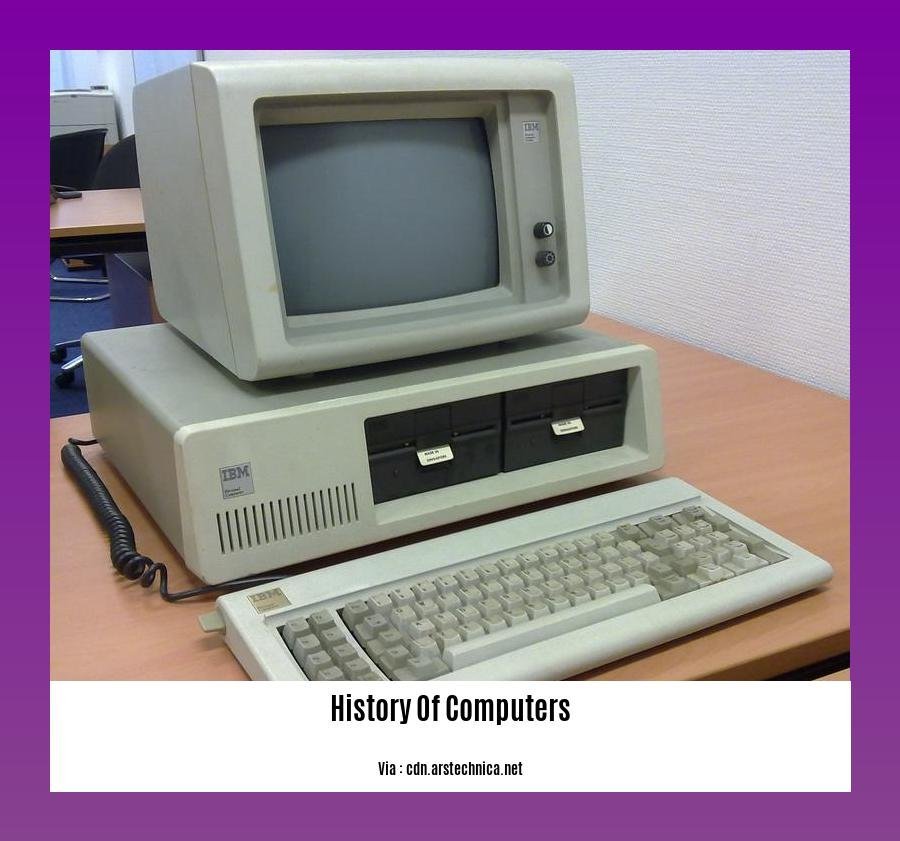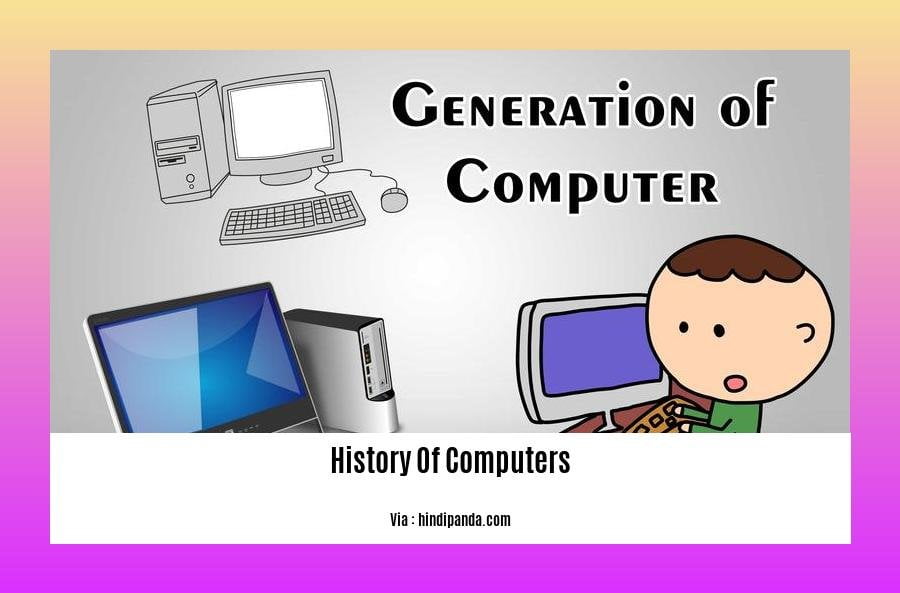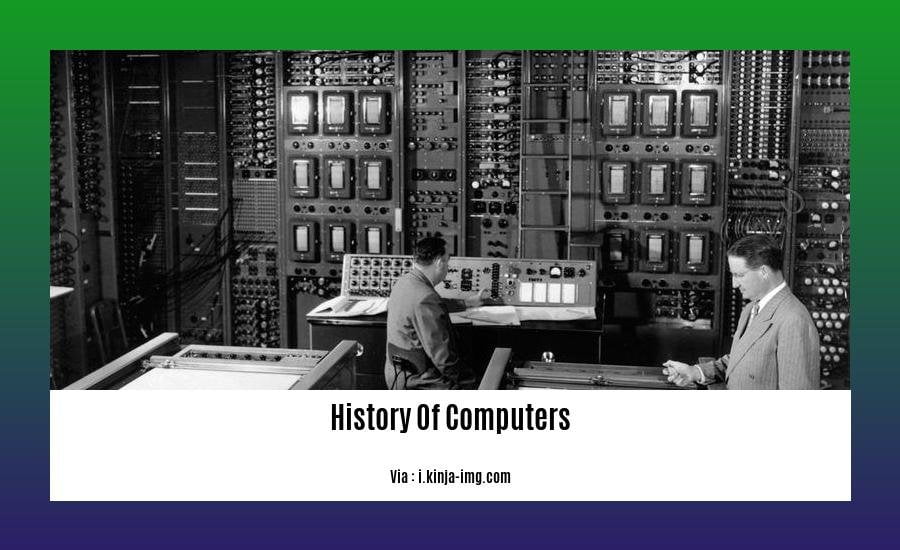Embark on an epic journey through [The Enduring Legacy: A Journey Through the History of Computers]. From the dawn of the first general-purpose electronic computer (ENIAC) to the advent of commercial microprocessors, this captivating narrative delves into the main characteristics of the first and second generations of computers, shaping the digital world we experience today.
Key Takeaways:
- The abacus was the first digital computer, invented in Mesopotamia around 2700 B.C.
- The Antikythera mechanism was the first analog computer, created around 200 B.C.
- Punched cards were first used in looms to automate cloth designs by Joseph Marie Jacquard in 1801.
- The Differential Analyzer, the first large-scale mechanical analog computer, was invented by Vannevar Bush in the 1930s.
- Personal computers emerged in the late 20th century.
- The 21st century has seen the rise of smartphones and tablets.
The Evolution of Computing: A Journey Through the History of Computers**

We live in a world where computing is so intricately woven into our daily lives that it’s hard to imagine a time without it. From the humble beginnings of simple calculations to the complex simulations of today, the journey of computing has been nothing short of captivating.
The history of computers is a captivating tale of human ingenuity and perseverance. It’s a story that spans centuries, beginning with the abacus in 2700 B.C. and culminating in the sleek smartphones and tablets we hold in our hands today.
Key milestones along this journey include:
1. 200 B.C.: The Antikythera mechanism, an analog computer capable of predicting celestial bodies’ positions.
2. 1801: Joseph Marie Jacquard’s automated loom, a forerunner of modern computer programming.
3. 1930: Vannevar Bush’s Differential Analyzer, a groundbreaking mechanical analog computer that could solve complex equations.
4. The late 20th century saw the rise of personal computers, making computing accessible to the masses.
5. In the 21st century, smartphones and tablets revolutionized mobile computing.
These innovations were brought to life by brilliant minds throughout the ages. From Ada Lovelace, the world’s first programmer, to Alan Turing, the father of computer science, these pioneers laid the foundation for the digital world we live in today.
The history of computers is not just a collection of dates and inventions. It’s a story of how human curiosity and relentless pursuit of knowledge have shaped our world. It’s a testament to the human spirit, forever pushing the boundaries of what’s possible.
As we look ahead, the future of computing is as exciting and unknown as ever. Will quantum computers unlock unimaginable possibilities? Will artificial intelligence become more human-like than humans themselves? Only time will tell, but one thing is for sure: the history of computers will continue to inspire and shape our world for generations to come.
Learn fascinating details about the rise of personal computing and how it revolutionized the way we interact with technology today. Discover the invention of the transistor, a groundbreaking discovery that paved the way for modern electronics. And delve into the intriguing history of mechanical calculating devices, tracing the evolution of computation from its humble beginnings.
The first large scale commercial microprocessor-based systems were developed in 1971

In 1971, the world witnessed a pivotal moment in the history of computing: the birth of the first commercially produced microprocessor. This groundbreaking innovation would forever alter the trajectory of technology and our digital landscape.
The 4-bit microprocessor, developed by Intel, ushered in a new era of computing. Its compact size, low cost, and ability to perform basic operations made it an ideal solution for various applications, from calculators to consumer electronics. This versatility paved the way for the proliferation of electronic devices and laid the foundation for the digital revolution.
Key Takeaways:
- The first commercially available microprocessor emerged in 1971.
- It possessed a 4-bit data path, enabling basic arithmetic and logical operations.
- Designed with a BCD (Binary-coded Decimal) instruction set for numeric applications.
- Its clock rate of 740-750 kHz ensured relatively swift execution for its time.
- Affordably priced at $60, it facilitated widespread adoption.
- The microprocessor’s longevity, with production continuing for a decade, attests to its enduring impact.
Sources:
The main characteristics of second generation of computers (1950s-1960s)
Moving beyond vacuum tubes, the second generation of computers marked a turning point in the digital realm, setting the stage for our modern technological landscape.
Key Takeaways:
- Reduced in size: These computers were significantly smaller, making them more mobile and accessible.
- Increased durability: Transistors replaced vacuum tubes, offering greater durability and a longer lifespan.
- Improved reliability: Transistors were less prone to failures, enhancing the overall reliability of these systems.
- Commercial production: Second-generation computers were the first to be produced commercially, signaling a shift towards widespread adoption.
Impact and Legacy
The second generation of computers laid the groundwork for today’s digital infrastructure. Their smaller size, increased durability, and improved reliability paved the way for more portable and dependable computing devices. Moreover, their commercial availability made computing accessible to a broader range of users.
Conclusion
The main characteristics of second generation of computers (1950s-1960s) ushered in a new era of computing, characterized by reduced size, increased durability, improved reliability, and commercial production. These advancements set the stage for the continued evolution of computing technology and shaped the digital landscape as we know it today.
Sources:
- The Main Characteristics of Second Generation of Computers
- Second Generation Computers – Characteristics and Advantages
FAQ
Q1: Which invention marked the dawn of the digital computing era?
A1: The abacus, invented in Mesopotamia around 2700 B.C., is regarded as the first digital computer.
Q2: What was the significance of the Antikythera mechanism?
A2: The Antikythera mechanism, created around 200 B.C., was an analog computer designed to predict astronomical events, demonstrating the early ingenuity in computational technology.
Q3: How did the microprocessor revolutionize computing?
A3: The release of the first commercially produced microprocessor, the Intel 4004 in 1971, enabled the development of personal computers and made computing more accessible.
Q4: What were the key advantages of second-generation computers?
A4: Second-generation computers, characterized by the use of transistors, offered significant advantages in size, durability, reliability, and commercial viability.
Q5: What was the distinctive feature of ENIAC, the first general-purpose electronic computer?
A5: ENIAC, developed during the 1940s and 1950s, was notable for its massive size, requiring an entire room to house its electronic components and punch card readers.




![A Journey Through the History of Computing: From Its Humble Origins to Modern Innovations [history of computing ss1] history-of-computing-ss1_2](https://www.lolaapp.com/wp-content/uploads/2023/12/history-of-computing-ss1_2-150x150.jpg)











